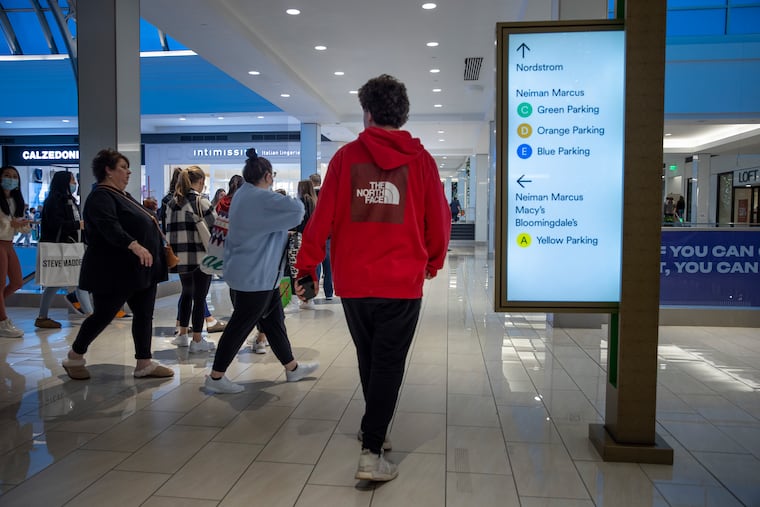Philly teens entering workforce in droves, filling holiday gaps amid ongoing labor shortage
With starting pay at $13 an hour, "I like having money in my pocket," says one teen.

Teenagers are filling the gaps in this year’s holiday labor shortage, part of a broad national trend in which 16- to 19-year-olds are entering the workforce in numbers not seen since 2008.
They’re needed, too: Retailers, grocers, and delivery services are clamoring for more workers. The National Retail Federation anticipates retailers will be hiring from 500,000 to 665,000 seasonal workers. Amazon is aiming to hire 150,000 seasonal workers.
And large employers such as Walmart are conducting hiring events for thousands of employees. UPS is holding UPS Brown Friday to hire extra holiday workers, with some shifts starting at $20 an hour.
So high school students including junior Luke Watson are stepping up. “I work about 16 hours a week, and there are quite a few coworkers around the same age as me,” said Watson, 16, who works as a cashier at ShopRite’s Union Mill Road store in Mount Laurel, N.J.
“I can tell they’re minors, because we all have yellow name tags,” he said.
Teen workers also appear more willing to work jobs that may not pay enough for older Americans.
“This is my first job. I’m really enjoying it,” said Nate McCollum, a 15-year-old high school sophomore. “It’s really nice to have money in my pocket. And I’ve met a lot of new people. It’s helped me experience new things.”
He and some of his friends from Upper Merion Area High School are also employed part-time. “Everyone’s bored and looking to get out of the house,” McCollum said.
There are unprecedented crosscurrents at work in the American labor force: plenty of potential workers, but a shortage of people willing to work at current wage levels, or without childcare, or amid the threat of COVID infection.
“This is like a quiet strike,” wrote Wolf Richter, a finance writer and investor, on wolfstreet.com.
The age group of 16- to 19-year-olds enter and leave the workforce in numbers that mirror recessions and expansions nationally, said Stephen Herzenberg, executive director of the Keystone Research Center in Harrisburg.
“We haven’t seen teen employment this high since the fall of 2008, right before the Great Recession,” Herzenberg said, when 32% of 16- to 19-year-olds were employed. Today that ratio of teens in the population is just over 32%.
The prior high for teen workers was 46% of the 16- to 19-year-old population in the year 2000, right before the dot.com bubble burst.
Pennsylvania is seeing the same trend: Monthly stats from the Department of Labor & Industry show a 12-month moving average of unemployment among 16- to 19-year-olds dropped more than any other group between August 2020 and August 2021, according to the Keystone Research Center.
“Anyone who thinks they have a single answer to the labor shortage doesn’t have the answer,” said Lara Rhames, chief economist at FS Investments. “It’s a combination of higher childcare costs, people with previously double-income families, early retirement, people moving, all kinds of factors.”
Inflation bites
How’s the pay? For Watson it’s $13 an hour at ShopRite. McCollum said he started at Panera Bread in King of Prussia this past summer at $9 an hour, and in early November, the company raised starting pay to $13 an hour for the staff nationally.
In Philadelphia, wages were due for a hike: Wage inflation has not kept up with overall inflation, according to new research from the Economy League of Greater Philadelphia, the think tank based in Center City.
“We always hear the mantra that Philly’s the poorest large city in the U.S. right now, but compared with other metro regions, we were one of the closest to the national average, and slightly below average, in inflation in housing, medical care, and food,” said Michael Shields, a project manager at the Economy League, specializing in data. That said, “with a high poverty rate, even a small price surge impacts the poorest the most.”
Between 2011 and 2021, the cost of everyday items increased 14.4% while average wages in the region only rose by 8.2% in real terms. “Workers in our region lost purchasing power during this period,” said Shields.
“The growing cost of everyday items in Greater Philadelphia measured by inflation has outpaced wage growth in the past decade,” said Shields.
It will be a real challenge to retailers to fill all of their seasonal openings given the overall labor shortages.
McCollum, for his part, is happy with his $13 an hour. He works most closing shifts on the weekends, except Sunday evening when he leaves at 7 p.m. due to schoolwork.
“Some of my friends work at Peppers [restaurant], and then another one had a job at a local ice cream shop, and another at Duck Donuts” in King of Prussia. Yet another worked as a pooper scooper, picking up animal waste on lawns. “I’m probably making more than most of them.”